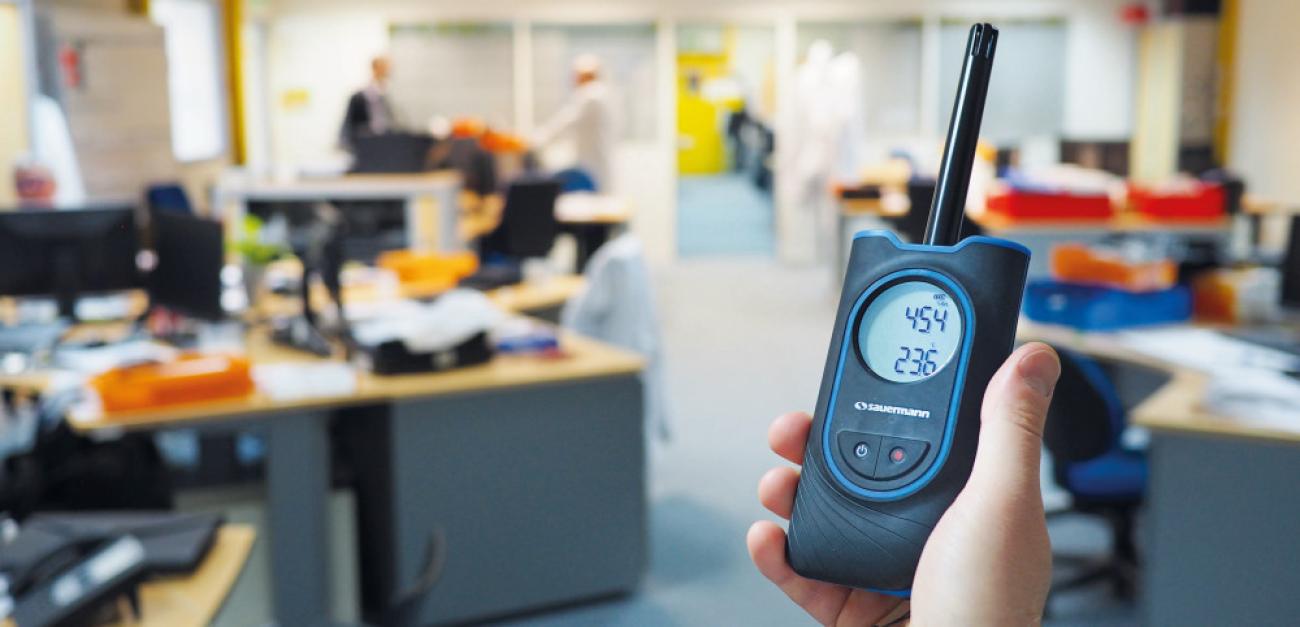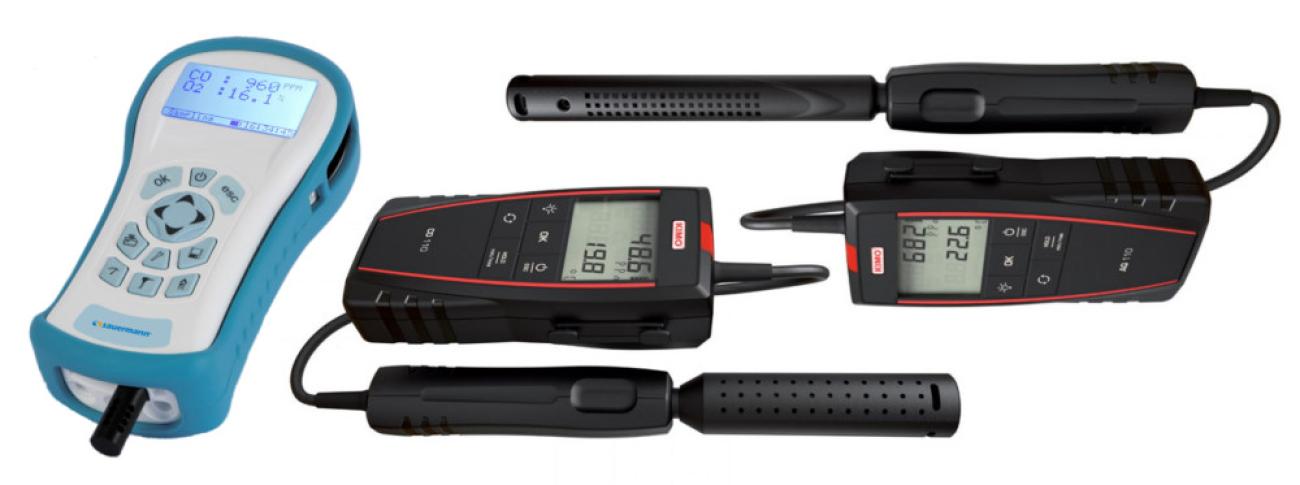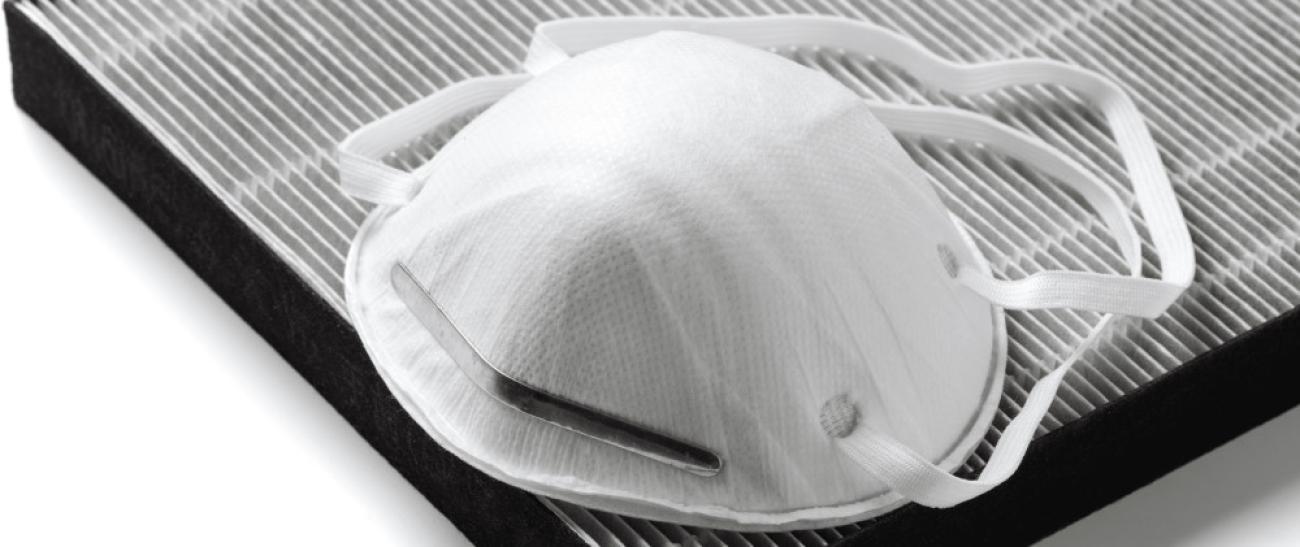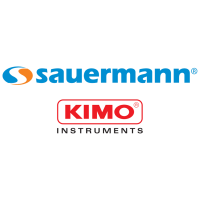Offices, schools: measuring air quality for maximum occupant health and comfort

The air quality inside a workplace can have a profound impact on the physical and mental state of its occupants, causing everything from drowsiness, irritability, and poor concentration, to allergies, diseases and even time off work. That’s why schools and businesses are increasingly interested in regular – and even constant – air quality monitoring in workspaces. But what parameters need to be measured and what are the ideal values?
Temperature
When it comes to making sure indoor air quality is conducive to a full day’s work, the temperature is the first and most obvious place to start. Ideally, the ventilation system should keep the temperature at between 21°C and 26°C all year round.
| Season | Minimum temperature (°C) | Maximum temperature (°C) |
| Heating (winter) | 21 | 23 |
| Air conditioning (summer) | 23 | 26 |
Humidity
Relative humidity is the second parameter of interest. While the ideal values are dependent on the temperature, there are some limits that should never be exceeded:
- A relative humidity value above 70% exacerbates feelings of heat and cold and, in some cases, can cause colds and other illnesses among occupants. At these levels, the moisture in the air can also promote the growth of mould and fungus, which in turn can cause allergies and present a heightened asthma risk.
- A relative humidity value below 30% means the air is so dry that it will cause occupants discomfort, from irritation of the eyes and mucous membranes, to dust allergies and more. What’s more, excessively dry air leads to unpleasant electrostatic discharge and is more conducive to the spread of viruses.
| Temperature (°C) | Minimum humidity (%) | Maximum humidity (%) |
| 18–21°C | 40 | 65 |
| 21–23°C | 35 | 60 |
| 23–26°C | 30 | 55 |
| The best instruments for measuring the temperature and relative humidity of indoor ambient air are thermo-hygrometers: | ||
| Fixed instruments | Portable instruments | Data loggers |

Wet-bulb globe temperature
The wet-bulb globe temperature (WBGT) is a psychrometric measurement that reflects the sensation of heat felt by wet skin when it’s exposed to moving air. Because it measures the minimum temperature achieved by evaporative cooling, it allows temperature and humidity values to be examined in the context of the air currents inside a room.
In practice, this measurement is used to check that blown air from an air vent doesn’t create discomfort or cause occupants to become ill. This artificial air current reduces the WBGT and can therefore be unpleasant or even harmful if it’s too powerful. Consequently, this measurement is mainly relevant in the air conditioning season. The values below apply to an indoor setting with occupants engaged in low-level physical activity (not sweating):
| Temperature (°C) | Minimum WBGT (°C) | Maximum WBGT (°C) |
| 18–21°C | 11 | 17 |
| 21–23°C | 12 | 18 |
| 23–26°C | 13 | 20 |
The WBGT is a more meaningful metric for outdoor physical activity. People are advised to take precautions (taking regular breaks and drinking plenty of water) at values of 25°C or higher in direct sunlight. At readings below 21°C, the danger is considered negligible, whereas WBGT values in excess of 28°C poses a serious risk to health (heart attacks, etc.).
| Measuring the WBGT requires a special wet-bulb probe, which is one of the accessories available for our portable, multifunction measurement instruments. |

Air velocity
Another more direct way to measure air currents inside a building is to use high-sensitivity hotwire technology – more specifically, an omnidirectional hotwire anemometer. The way in which an air current affects occupant comfort depends on the temperature and humidity of the air and, of course, its velocity:
| Indoor air velocity | Sensation |
| Less than 0.1 m/s | Air current is imperceptible or insufficient relative to stagnant air (air change rate is too low) |
| Between 0.1 and 0.2 m/s | Maintains optimal comfort in offices |
| Between 0.2 and 0.3 m/s | Creates a sensation of discomfort for people who are seated (in offices) |
| Between 0.3 and 0.4 m/s | Unsuitable for offices, tolerable in spaces where people are engaged in physical activity |
| More than 0.4 m/s | Helps keep people cool during physical activity and cools areas where heat is generated |
The best way to maintain a high enough air change rate without the air currents causing discomfort for occupants is to use diffusers – a type of air vent that blows air in all directions without generating a direct current, thereby reducing the sensation of moving air felt by people inside the room.
| Because our VT 110 hotwire thermo-anemometers are highly sensitive and can also take simultaneous temperature readings, they’re the ideal instruments for measuring air currents. And for more in-depth measurement capabilities, nothing beats one of our multifunction instruments coupled with the SOM 900 omnidirectional hotwire probe. |

Air change rate
Air change rate (ACR) has become a critical measurement in recent times, primarily for health reasons. Replacing the air – by injecting an adequate supply of fresh, filtered air – helps to reduce the concentration of impurities, bacteria and viruses inside a room. We’ve discussed this subject at length in several posts and articles.
Our first ACR-related article takes a conventional approach to the subject, providing recommended ACR values for different types of spaces. Meanwhile, another one of our articles takes a more detailed look at how to calculate the ideal ACR depending on the number of occupants and the nature of their activity, using CO2 concentration as the target indicator.
ACR is calculated by measuring the flow of air blown into a room and checking that air flows out through the outlet vents at a similar rate.
| The best instrument for taking these types of readings is an air flow meter such as our DBM 620 model (read our separate article about the best methods for measuring air flow rate at an air vent). |

CO2 concentration
CO2 concentration is now accepted as one of the most important parameters for assessing indoor air quality – for two reasons.
First, the amount of CO2 contained in indoor air has important implications for occupants’ concentration and health. We talked about this issue in detail in this article, which discusses the effects of different CO2 concentrations on the occupants of a room.
Second, CO2 concentration is a key indicator of the rate at which air is replenished in a confined space. Maintaining levels within the recommended range of 800 to 1,000 ppm helps to prevent the spread of bacteria and viruses in indoor settings.
| The only way to reliably measure CO2 concentration is to use premium non-dispersive infrared (NDIR) sensors, which are available for all Sauermann instruments: | ||
| Fixed instruments | Portable instruments | Data loggers |

Pollutant concentration
Indoor spaces can become contaminated with various pollutants from construction work or from the outdoor environment. Volatile organic compounds (VOCs), which are often found indoors and are especially harmful, are especially concerning.
| Pollutant | Optimal level | Monitoring required | Dangerous level |
| Carbon monoxide (CO) | 0 – 8 PPM | 8 – 15 PPM | > 15 PPM |
| Total VOCs (TVOCs) | 0 – 300 PPB | 300 – 750 PPB | > 750 PPB |
| Formaldehyde (HCHO) | 0 – 25 PPB | 25 – 250 PPB | > 250 PPB |
| Ozone (O3) | 0 – 50 PPB | 50 – 70 PPB | > 70 PPB |
| Nitrogen oxides (NOx) | 0 – 0,1 PPM | 0,1 – 2 PPM | > 2 PPM |
| Nitrogen dioxide (NO2) | 0 – 0,1 PPM | 0,1 – 1 PPM | > 1 PPM |
| Hydrogen sulphide (H2S) | 0 – 2 PPM | 2 – 5 PPM | > 5 PPM |
| Sulphur dioxide (SO2) | 0 – 0,1 PPM | 0,1 – 1 PPM | > 1 PPM |
ppm: parts per million / ppb: parts per billion
| It’s important to monitor concentrations of these pollutants regularly using specialist indoor air quality measurement instruments. |

Particle concentration
Particles of all types and sizes can be suspended in indoor air, from large dust particles through to micro and even nanoparticles. The smaller these particles, the more likely they are to be absorbed into the lungs and the body as a whole. It’s especially important to monitor this type of pollution in industrial workplaces, using specialist instruments.
| Particle size | Maximum annual value (ideal) | Daily limit value | Daily danger threshold |
| PM 2.5 (diameter ≤ 2.5 microns) | 15 µg/m3 | 30 µg/m3 | 50 µg/m3 |
| PM 10 (diameter ≤ 10 microns) | 25 µg/m3 | 50 µg/m3 | 80 µg/m3 |

Light and noise
Workplaces also need monitoring for other potential causes of discomfort, such as light and noise. A lux meter can be used to check that the light in an indoor space is suitable for the occupants’ activities. The recommended values are 250-500 lux for traditional office work and 1,000-2,000 lux for high-precision tasks. Meanwhile, noise levels in an open-plan office space shouldn’t exceed 55 dB (learn more about measuring noise in decibels in this article).





Add new comment